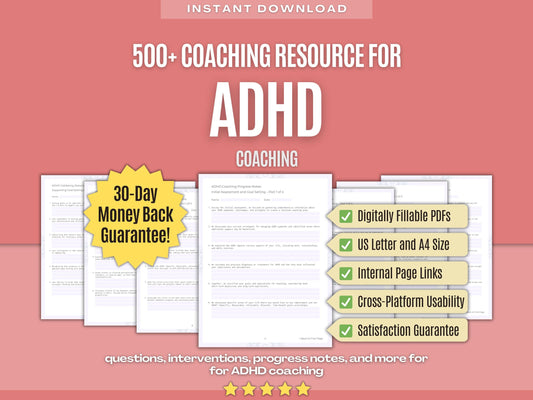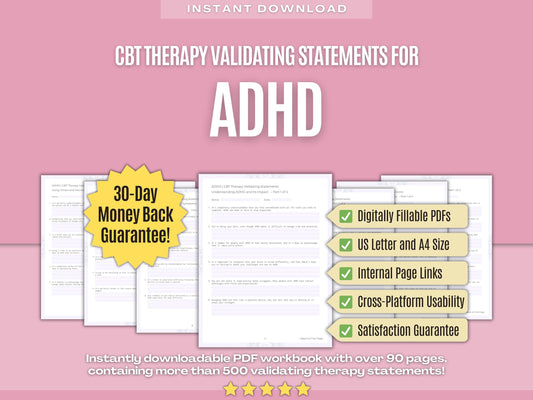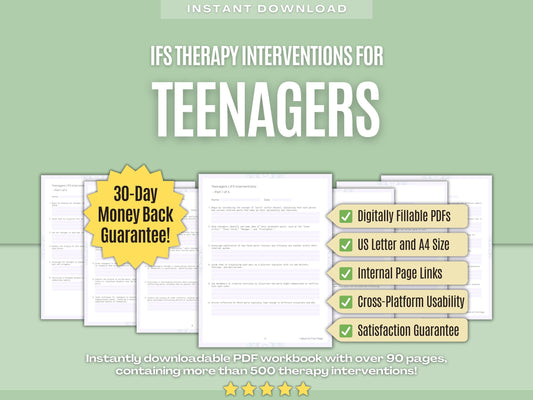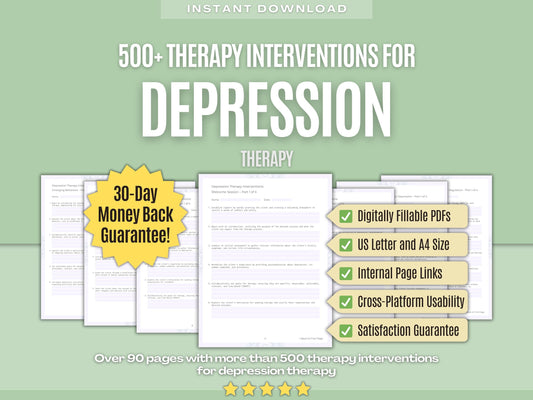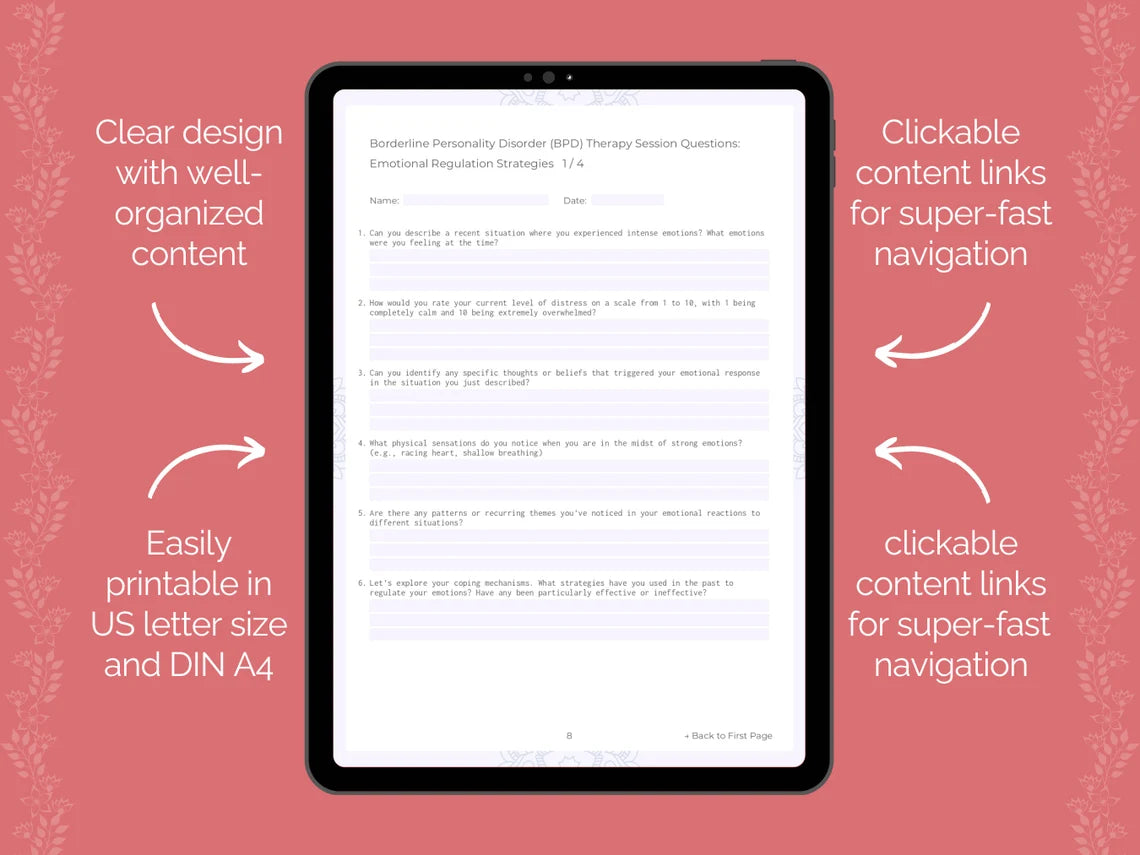Elevate Your Therapy and Guide Your Clients to Inner Healing with Our Grief and Loss Therapy Interventions! ✨
1. Therapy Introduction
- Begin the therapy introduction by establishing rapport with the client, creating a warm and welcoming atmosphere to facilitate trust and openness.
- Conduct an initial assessment to gather information about the client's history of loss, their current symptoms, and their readiness to engage in therapy.
- Explore the client's expectations and hopes for therapy, clarifying any misconceptions and aligning goals with realistic outcomes.
- Discuss the concept of "normal grief" and validate the wide range of emotions and experiences that clients may encounter during their grief journey.
- Introduce the therapist-client relationship as a safe space for exploration and healing, emphasizing confidentiality and non-judgmental acceptance.
- Explore the client's cultural or spiritual beliefs about grief and loss, acknowledging the influence of cultural norms and values on their grieving process.
- Encourage the client to express their emotions freely during therapy sessions, providing validation and empathy for their experiences.
- Explore the client's coping mechanisms and identify both adaptive and maladaptive strategies for managing grief symptoms.
- Discuss potential challenges or barriers to therapy, such as resistance to change or fear of confronting painful emotions, and develop strategies for overcoming these obstacles.
- Assess the client's readiness to engage in deeper emotional work and explore their level of comfort with discussing painful or traumatic memories.
- Provide information about additional resources and support services that may complement therapy, such as support groups, online forums, or self-help books.
Need more? Find all 500+ Therapy Interventions for Grief and Loss Therapy in our Digital Workbook!
2. Understanding Grief and Loss
- Begin by exploring the client's understanding of grief and loss, allowing them to share their beliefs and perceptions about what constitutes grief and how it manifests in their life.
- Discuss the various types of losses that can trigger grief reactions, including death of a loved one, divorce, job loss, or relocation, helping the client recognize that grief is not limited to bereavement.
- Explore the cultural and societal influences on the client's understanding of grief and loss, acknowledging that cultural norms and expectations may shape their grieving process.
- Use metaphors or analogies to help the client conceptualize the grieving process, making complex concepts more accessible and understandable.
- Introduce alternative models of grief, such as William Worden's tasks of mourning (accepting the reality of the loss, experiencing the pain of grief, adjusting to a world without the deceased, finding a connection with the deceased while embarking on a new life), allowing the client to explore different frameworks for understanding their grief process.
- Explore the physical symptoms of grief, such as fatigue, changes in appetite, or sleep disturbances, helping the client recognize the somatic manifestations of their grief.
- Explore the emotional symptoms of grief, such as sadness, anger, guilt, or anxiety, validating the client's emotional experiences and providing validation and support.
- Explore the social dimensions of grief, including changes in relationships and support systems following a loss, and identify sources of social support that may be available to the client.
- Discuss the concept of "secondary losses," such as changes in roles or identity following a loss, helping the client recognize the ripple effects of grief in their life.
- Use case examples or personal stories to illustrate different aspects of the grieving process, making abstract concepts more concrete and relatable for the client.
- Discuss the role of self-care in the grieving process, emphasizing the importance of attending to one's physical, emotional, and spiritual needs during times of loss.
Need more? Find all 500+ Therapy Interventions for Grief and Loss Therapy in our Digital Workbook!
3. Mindfulness for Mourning
- Begin with a guided mindfulness meditation session, focusing on the breath to ground clients in the present moment.
- Introduce body scan exercises to help clients cultivate awareness of physical sensations associated with grief and loss.
- Use mindful eating exercises, encouraging clients to slow down and savor each bite, noticing the taste, texture, and sensations.
- Guide clients in exploring their grief-related thoughts and emotions with nonjudgmental awareness, acknowledging them without getting caught up in them.
- Introduce gratitude practices, encouraging clients to reflect on aspects of their life for which they are thankful despite their loss.
- Incorporate gentle movement practices such as yoga or Tai Chi to help clients reconnect with their bodies and release emotional tension.
- Use guided imagery exercises to help clients visualize a peaceful place where they can find comfort and solace.
- Practice mindful listening exercises, where clients attentively listen to sounds in their environment without judgment or interpretation.
- Explore the concept of interconnectedness, helping clients recognize their connection to others who have also experienced loss.
- Introduce progressive muscle relaxation exercises to help clients release physical tension and stress associated with grief.
- Explore the role of acceptance in the grieving process, helping clients cultivate acceptance of their emotions and circumstances.
Need more? Find all 500+ Therapy Interventions for Grief and Loss Therapy in our Digital Workbook!
4. Dialectical Behavior Therapy (DBT) for Emotional Regulation
- Begin by introducing the core principles of Dialectical Behavior Therapy (DBT), emphasizing the importance of balancing acceptance and change in coping with grief and loss.
- Utilize mindfulness techniques to help clients observe and describe their emotions without judgment, allowing them to experience their feelings without becoming overwhelmed.
- Guide clients in creating a personalized distress tolerance toolkit, which may include items or activities that provide comfort and help them manage emotional distress.
- Teach clients the STOP skill (Stop, Take a step back, Observe, Proceed mindfully) to interrupt impulsive or reactive behaviors and respond to grief-related triggers more effectively.
- Implement behavioral chain analysis to help clients understand the sequence of events, thoughts, and emotions that lead to maladaptive coping behaviors in response to grief.
- Collaborate with clients to identify and challenge cognitive distortions or irrational beliefs that contribute to emotional dysregulation in response to grief and loss.
- Facilitate interpersonal effectiveness skills training to help clients communicate assertively, set boundaries, and navigate relationships with others who may also be grieving.
- Introduce self-soothing techniques, such as deep breathing, progressive muscle relaxation, or visualization, to help clients regulate their physiological arousal in response to grief-related stressors.
- Use guided imagery or visualization exercises to help clients imagine a safe and comforting place they can retreat to during moments of emotional distress.
- Introduce radical openness skills to help clients approach their grief experience with curiosity, flexibility, and a willingness to learn and grow from their emotions.
- Guide clients in setting specific, measurable, achievable, relevant, and time-bound (SMART) goals related to emotional regulation and coping with grief and loss.
Need more? Find all 500+ Therapy Interventions for Grief and Loss Therapy in our Digital Workbook!
5. Interpersonal Therapy (IPT) for Social Support
- Begin by introducing the principles of Interpersonal Therapy (IPT), emphasizing its focus on the relationship between grief and interpersonal dynamics.
- Utilize the social network assessment to help clients map out their social support system, including family members, friends, coworkers, and other significant figures.
- Use role-playing exercises to help clients practice assertive communication skills for expressing their needs, boundaries, and preferences to others in their social support network.
- Introduce the concept of social rhythm therapy, emphasizing the importance of maintaining regular social activities and connections as a way of coping with grief and preventing isolation.
- Encourage clients to engage in activities or hobbies that facilitate social interaction and connection, such as joining a support group, volunteering, or participating in community events.
- Use psychoeducation to help clients understand the importance of social support in coping with grief and the potential benefits of reaching out to others for assistance and companionship.
- Utilize the use of letter-writing exercises to facilitate communication with significant others who may be involved in the client's grief process, expressing thoughts, feelings, and needs.
- Use the use of behavioral activation techniques to help clients increase their engagement in social activities and connections, even when they may not feel motivated to do so.
- Encourage clients to explore the potential benefits of online or virtual support networks and resources, especially for those who may have limited access to in-person support.
- Provide ongoing validation, support, and encouragement as clients work to enhance their social support networks and navigate the complexities of grief within interpersonal relationships.
- Use role-playing exercises to help clients practice effective coping strategies and communication skills for managing conflicts or disagreements within their social relationships.
Need more? Find all 500+ Therapy Interventions for Grief and Loss Therapy in our Digital Workbook!
6. Emotion-Focused Therapy (EFT) for Emotional Healing
- Begin by introducing the principles of Emotion-Focused Therapy (EFT), emphasizing its focus on exploring and processing emotions as a central aspect of grief and healing.
- Utilize empathic attunement to validate and empathize with the client's emotional experience, helping them feel understood and accepted.
- Explore the client's emotional responses to grief, helping them identify and label their emotions with precision and accuracy.
- Encourage clients to express their emotions through creative outlets, such as art, music, or movement, as a way of accessing and processing their feelings.
- Encourage clients to engage in self-soothing activities that provide comfort and relief from emotional distress, such as deep breathing, progressive muscle relaxation, or visualization.
- Utilize the use of emotion-focused journaling exercises to help clients express and process their emotions, thoughts, and experiences related to grief.
- Facilitate the use of emotion-focused imagery rescripting to help clients reframe and transform distressing memories or images related to their loss.
- Explore the function and purpose of the client's emotions in the context of their grief experience, helping them understand how their emotions serve as valuable signals and guides.
- Encourage clients to engage in emotion-focused self-reflection, asking questions such as "What am I feeling right now?" and "What do I need in this moment?"
- Explore the role of attachment-related emotions, such as longing or yearning, in the client's grief experience, helping them navigate their attachment bonds in the face of loss.
- Utilize the use of metaphorical language and storytelling to help clients externalize and explore their emotions in a symbolic and creative way.
Need more? Find all 500+ Therapy Interventions for Grief and Loss Therapy in our Digital Workbook!
7. Psychodynamic Exploration of Loss
- Begin by introducing the core principles of psychodynamic therapy and its relevance to understanding the complexities of grief and loss, emphasizing the exploration of unconscious processes, early attachment experiences, and internal conflicts.
- Utilize open-ended questions and active listening to create a safe and supportive therapeutic space where clients feel comfortable exploring their thoughts, feelings, and memories related to their loss.
- Encourage clients to explore any unresolved issues or conflicts in their relationship with the deceased, helping them process feelings of guilt, anger, regret, or ambivalence.
- Explore the client's internalized representations of the deceased, helping them understand how these internal objects may influence their grief reactions and coping strategies.
- Utilize the use of dream analysis as a tool for uncovering unconscious themes, symbols, and conflicts related to grief and loss, helping clients gain insight into their emotional experiences.
- Facilitate the exploration of any cultural or familial influences on the client's grief experience, helping them identify and challenge any internalized beliefs or expectations that may be shaping their grieving process.
- Encourage clients to explore any feelings of guilt, shame, or self-blame related to their loss, helping them understand and work through these complex emotions.
- Facilitate the exploration of the client's relationship with death and mortality, helping them confront and come to terms with their own mortality in the context of their grief.
- Utilize the use of psychodynamic interpretation to help clients gain insight into the deeper meanings and significance of their grief reactions, dreams, or fantasies.
- Encourage clients to explore any ambivalent or conflicted feelings toward the deceased, helping them navigate the complexities of their emotional landscape with compassion and understanding.
- Facilitate discussions about the client's coping strategies and adaptive mechanisms, helping them identify and strengthen healthy coping strategies while exploring and addressing maladaptive patterns.
Need more? Find all 500+ Therapy Interventions for Grief and Loss Therapy in our Digital Workbook!
8. Healing through Music Therapy
- Begin by introducing the concept of music therapy as a powerful tool for emotional expression, processing, and healing in the context of grief and loss, emphasizing its ability to access deep-seated emotions and facilitate connection with oneself and others.
- Encourage clients to create personalized playlists of songs that evoke specific emotions or memories related to their loss, allowing them to access and process their grief through familiar and meaningful music.
- Use improvisation techniques to help clients express their emotions through instrumental music, allowing them to communicate and release pent-up feelings in a non-verbal and spontaneous way.
- Use lyric analysis exercises to help clients explore the meaning and symbolism of song lyrics related to grief and loss, facilitating discussion and reflection on their personal relevance and significance.
- Encourage clients to engage in music-assisted relaxation and meditation exercises, using soothing music to promote relaxation, stress reduction, and emotional healing.
- Facilitate the use of music as a form of ritual or ceremony to honor the memory of the deceased and commemorate important milestones in the grief process.
- Use guided songwriting exercises to help clients create personalized songs or musical compositions that express their thoughts, feelings, and experiences related to grief.
- Facilitate the exploration of different music genres and styles as a way of accessing and expressing a range of emotions related to grief, from sadness and anger to hope and resilience.
- Encourage clients to create music-inspired artwork or visual representations of their grief experience, using music as a source of inspiration and expression in their creative process.
- Use music-assisted guided imagery exercises to help clients explore and process difficult emotions and memories related to their grief, using music to create a supportive and therapeutic container for the experience.
- Facilitate the use of music as a form of self-care and coping, encouraging clients to create personalized self-soothing playlists or engage in music-making activities that promote relaxation and emotional well-being.
Need more? Find all 500+ Therapy Interventions for Grief and Loss Therapy in our Digital Workbook!
9. Concluding Grief Therapy
- Review and reflect on the client's progress throughout the grief therapy process, highlighting their strengths, insights, and growth since the beginning of therapy.
- Validate the client's experiences and emotions, acknowledging the complexity and depth of their grief journey and offering empathy and understanding.
- Reflect on the therapeutic relationship and the client's experience of therapy, inviting feedback and discussing any thoughts or feelings about the therapy process.
- Explore any changes or shifts in the client's beliefs, values, or priorities as a result of their grief experience, helping them integrate these changes into their sense of self.
- Encourage the client to engage in self-care practices and activities that promote emotional well-being and resilience, such as exercise, mindfulness, and creative expression.
- Discuss strategies for maintaining connections with the deceased loved one in healthy and adaptive ways, such as creating rituals or dedicating time for remembrance.
- Review any tools, techniques, or resources introduced in therapy that the client found helpful, providing guidance on how they can continue to use these tools in their daily life.
- Explore any feelings of guilt, anger, or regret that may still be present for the client, helping them process and release these emotions in a safe and supportive environment.
- Explore the client's sense of meaning and purpose in the wake of their loss, helping them find meaning and significance in their grief experience.
- Explore the client's relationship with their own mortality and any existential questions or concerns that may have emerged in the context of their grief.
- Discuss strategies for integrating the loss into the client's life story and identity in a way that honors the memory of their loved one while also allowing them to move forward.
Need more? Find all 500+ Therapy Interventions for Grief and Loss Therapy in our Digital Workbook!
10. Pathways to Healing
- Begin by exploring the client's unique grief journey, acknowledging the individuality of their experience and the various pathways to healing that may be available to them.
- Provide psychoeducation about the grieving process, helping the client understand the normalcy of their emotions and the stages of grief they may encounter.
- Discuss strategies for self-care and emotional well-being, such as exercise, mindfulness, and creative expression, to help the client manage their grief in healthy and adaptive ways.
- Explore the client's beliefs and values surrounding grief and loss, helping them find meaning and purpose in their experience and incorporating their beliefs into their healing process.
- Facilitate discussions about the deceased loved one and their impact on the client's life, helping the client find ways to honor and remember their loved one while also adapting to life without them.
- Discuss strategies for managing grief triggers and reminders, helping the client develop coping skills and resilience in the face of difficult emotions and memories.
- Provide validation and normalization of the client's grief experience, affirming the significance of their loss and the depth of their emotions.
- Encourage the client to engage in activities that promote connection and community, whether it's volunteering, joining a support group, or participating in group therapy.
- Explore the role of forgiveness and reconciliation in the grief process, helping the client find peace and resolution in their relationships, both with the deceased and with themselves.
- Facilitate discussions about the significance of rituals and ceremonies in the grief process, helping the client find ways to create meaning and closure in their grief journey.
- Encourage the client to explore their grief through creative expression, whether it's writing, art, music, or movement, as a way of processing and expressing their emotions.
We hope that our therapy interventions for Grief and Loss therapy will help you to elevate your therapy practice and guide your clients to inner healing! Do you need more therapy interventions for Grief and Loss therapy? Find them all in our Digital Workbook! Or do you have any questions or suggestions for us? Please feel free to contact us at any time!


